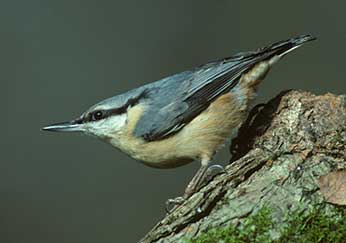Nuthatch (Sitta europaea)
When: Throughout the year
How many: Relatively abundant

Nuthatches are common and widespread in the New Forest woodlands, but it’s always a treat to see or hear these dapper creatures clambering up aged, moss-clad trunks.
They’re dumpy looking, robin-sized birds, smart in an under-stated sort of way. Nuthatch plumage is steel-blue / grey above, white about the throat, rusty/buff on chest and belly, and with a bold, dark eye-stripe. And, particularly in the male nuthatch, darker, but rather inconspicuous chestnut flanks add a subdued splash of colour.
Nuthatches have quite short, rounded wings that offer maximum manoeuverability in cluttered, woodland settings, whilst restless, jerky nuthatch movements create an impression of all-action alertness. Strong legs and claws enable trunks and boughs to be travelled, face-on, in all directions including downwards, a skill not possessed by even treecreepers or woodpeckers.
Obviously powerful head; thick, barely discernable neck; and long, impressively strong, dagger-like bill have all evolved to enable nuthatches to hammer open seeds and nuts, often after they have been placed, vice-like, in a bark fissure or crevice.
Nuthatches are strongly territorial all year round, often remaining paired and living in the same modestly sized area through the seasons, depending for their survival on an intimate knowledge of their patch.
Not surprisingly for such strongly territorial creatures, nuthatches are excitable, aggressive and rarely quiet. Indeed, their far-carrying, ringing, metallic cries epitomise New Forest woodlands in just about every month of the year, brightening even the dullest winter’s day.
Nuthatch nests – often no more than a sprinkling of bark flakes on a base of wood chippings - are in natural tree holes or those originally drilled by other birds. Residence by a nuthatch is often betrayed, though, by dried, hardened mud plastered around the entrance, a practice that reduces nest site competition from other, larger birds, and helps keep out predators, such as woodpeckers, that enjoy nothing more than meals of eggs and nestlings.
First year nuthatches disperse, but rarely travel far, and hardly ever over water – the nuthatch is virtually unknown on the Isle of Wight, even though from the New Forest the Island is no more than a short hop across the Solent.
John Wise, in the middle of the 19th century, noted the presence of nuthatches in the New Forest, but provided no further details, whilst John Clare earlier in the same century recorded details of the nuthatch in his own charming, absolutely characteristic way:
'Of a beautiful color not unlike the blue titmouse but larger - runs about trees like the woodpecker and is seldom seen as it haunts solitary places - I have never found its nest but I should expect that it builds in trees - there are tales of its being able to crack nuts but I can say nothing for its authenticity.’
But in talking about lack of nuthatch sightings, Clare was referring to his native, fen-edge Northamptonshire, where limited woodland cover no doubt explained the scarcity.
The nuthatch was, though, up to at least the end of the 19th century, somewhat irregularly and locally distributed in much of Britain, whilst now the British Trust for Ornithology (BTO) reports rapidly increased abundance since the mid-1970s, and range expansion into northern England, associated with a large increase in brood size.
References:
Collins Bird Guide: Killian Mullarney, Lars Svensson, Dan Zetterstrom and Peter J.Grant
The Shell Guide to the Birds of Britain and Ireland: James Ferguson-Lees, Ian Willis and J.T.R. Sharrock
The Birds of the Western Palearctic, Concise Edition: D.W. Snow and C.M. Perrins
The Migration Atlas: British Trust for Ornithology
The Historical Atlas of Breeding Birds in Britain and Ireland, 1875-1900: Simon Holloway
John Clare’s Birds: Edited by Eric Robinson and Richard Fitter
More links
Other related links
Search this site

Sadly, 58 animals were killed - 35 ponies, 13 cows, 8 donkeys and 2 sheep, whilst a further 32 were injured - 3 pigs, 9 donkeys, 11 cows and 9 ponies.
(Forty-three accidents occurred in daylight, 15 at twilight and 101 in the dark. Twenty-seven accidents were not reported by the driver involved).
Here's just one horrific example - Three donkeys killed in collision with van at notorious New Forest blackspot (Advertiser and Times)

